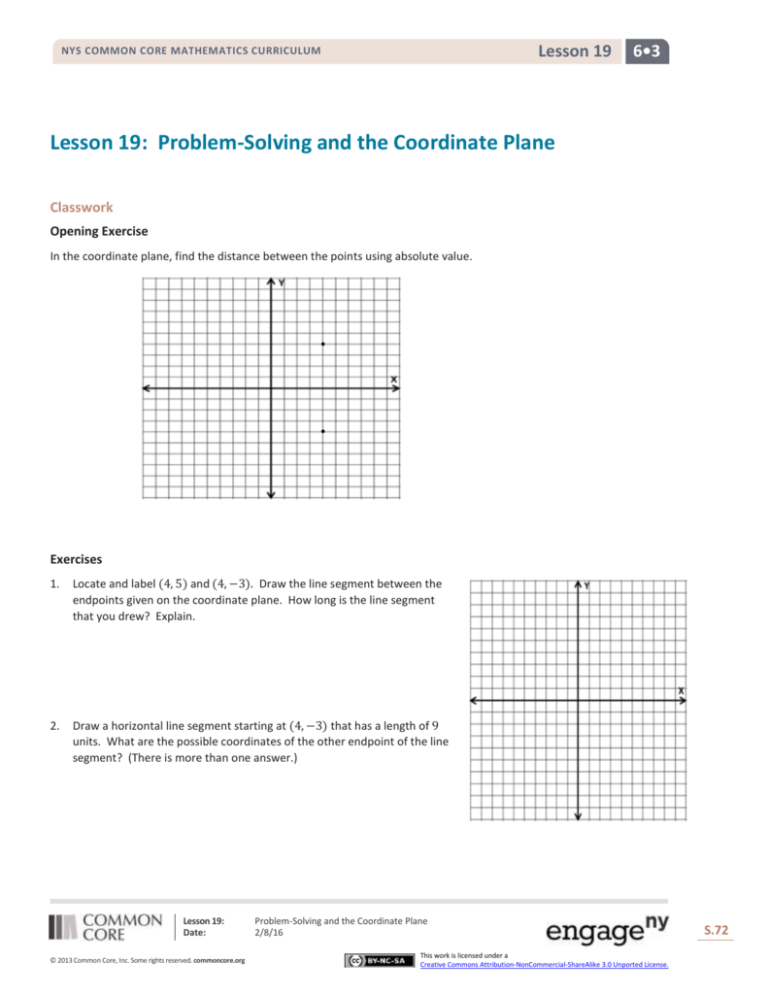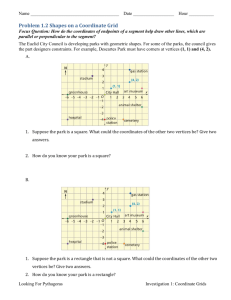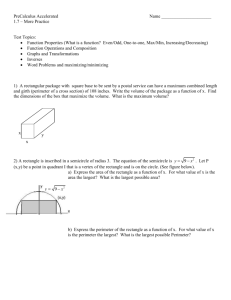
Lesson 19
NYS COMMON CORE MATHEMATICS CURRICULUM
6•3
Lesson 19: Problem-Solving and the Coordinate Plane
Classwork
Opening Exercise
In the coordinate plane, find the distance between the points using absolute value.
.
.
Exercises
1.
Locate and label (4, 5) and (4, −3). Draw the line segment between the
endpoints given on the coordinate plane. How long is the line segment
that you drew? Explain.
2.
Draw a horizontal line segment starting at (4, −3) that has a length of 9
units. What are the possible coordinates of the other endpoint of the line
segment? (There is more than one answer.)
Lesson 19:
Date:
© 2013 Common Core, Inc. Some rights reserved. commoncore.org
Problem-Solving and the Coordinate Plane
2/8/16
S.72
This work is licensed under a
Creative Commons Attribution-NonCommercial-ShareAlike 3.0 Unported License.
72
Lesson 19
NYS COMMON CORE MATHEMATICS CURRICULUM
6•3
Which point do you choose to be the other endpoint of the horizontal line segment? Explain how and why you
chose that point. Locate and label the point on the coordinate grid.
3.
The two line segments that you have just drawn could be seen as two sides of a rectangle. Given this, the endpoints
of the two line segments would be three of the vertices of this rectangle.
a.
Find the coordinates of the fourth vertex of the rectangle. Explain how you find the coordinates of the fourth
vertex using absolute value.
b.
How does the fourth vertex that you found relate to each of the consecutive vertices in either direction?
Explain.
c.
Draw the remaining sides of the rectangle.
4.
Using the vertices that you have found and the lengths of the line segments between them, find the perimeter of
the rectangle.
5.
Find the area of the rectangle.
Lesson 19:
Date:
© 2013 Common Core, Inc. Some rights reserved. commoncore.org
Problem-Solving and the Coordinate Plane
2/8/16
S.73
This work is licensed under a
Creative Commons Attribution-NonCommercial-ShareAlike 3.0 Unported License.
73
Lesson 19
NYS COMMON CORE MATHEMATICS CURRICULUM
6.
6•3
Draw a diagonal line segment through the rectangle with opposite vertices for endpoints. What geometric figures
are formed by this line segment? What are the areas of each of these figures? Explain.
EXTENSION [If time allows]: Line the edge of a piece of paper up to the diagonal in the rectangle. Mark the length
of the diagonal on the edge of the paper. Align your marks horizontally or vertically on the grid and estimate the
length of the diagonal to the nearest integer. Use that estimation to now estimate the perimeter of the triangles.
7.
Construct a rectangle on the coordinate plane that satisfies each of the criteria listed below. Identify the coordinate
of each of its vertices.
Each of the vertices lies in a different quadrant.
Its sides are either vertical or horizontal.
The perimeter of the rectangle is 28 units.
Using absolute value, show how the lengths of the sides of your
rectangle provide a perimeter of 28 units.
Lesson 19:
Date:
© 2013 Common Core, Inc. Some rights reserved. commoncore.org
Problem-Solving and the Coordinate Plane
2/8/16
S.74
This work is licensed under a
Creative Commons Attribution-NonCommercial-ShareAlike 3.0 Unported License.
74
Lesson 19
NYS COMMON CORE MATHEMATICS CURRICULUM
6•3
Lesson Summary
The length of a line segment on the coordinate plane can be determined by finding the distance between
its endpoints.
You can find the perimeter and area of figures such as rectangles and right triangles by finding the lengths
of the line segments that make up their sides, and then using the appropriate formula.
Problem Set
Please provide students with three coordinate grids to use in completing the Problem Set.
1.
One endpoint of a line segment is (−3, −6). The length of the line segment is 7 units. Find four points that could
serve as the other endpoint of the given line segment.
2.
Two of the vertices of a rectangle are (1, −6) and (−8, −6). If the rectangle has a perimeter of 26 units, what are
the coordinates of its other two vertices?
3.
A rectangle has a perimeter of 28 units, an area of 48 square units, and sides that are either horizontal or vertical. If
one vertex is the point (−5, −7) and the origin is in the interior of the rectangle, find the vertex of the rectangle
that is opposite (−5, −7).
Lesson 19:
Date:
© 2013 Common Core, Inc. Some rights reserved. commoncore.org
Problem-Solving and the Coordinate Plane
2/8/16
S.75
This work is licensed under a
Creative Commons Attribution-NonCommercial-ShareAlike 3.0 Unported License.
75










